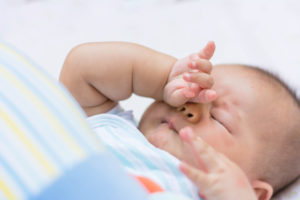When you buy through our links, we may earn a commission. Products or services may be offered by an affiliated entity. Learn more.
Sudden Infant Death Syndrome (SIDS) and Sleep
- Most cases of SIDS happen while an infant is asleep or in their sleeping environment.
- Risk factors for SIDS include side or stomach sleeping, age, and bed sharing.
- Caregivers can reduce the risk of SIDS by placing infants on their back to sleep.
- Setting up a safe sleeping surface, sharing a bedroom with an infant, and following other recommended practices can also lower SIDS risk.
Sudden unexpected infant death, often referred to as SUID, is a term used when a newborn or infant dies unexpectedly for no known reason. A subset of these fatalities is classified as SIDS, or sudden infant death syndrome.
Most instances of SIDS occur when an infant is asleep or in their sleep area, between the hours of midnight and 6 a.m. . While SIDS is not attributed to a singular cause, caregivers can reduce the risk of SIDS by preparing and maintaining a safe sleeping environment for their infant. Learning more about SIDS and important preventive measures can help protect sleeping infants.
What Is SIDS?
SIDS is a term used to describe any sudden and unexpected death, whether explained or unexplained, occurring during infancy. Previously referred to as crib death or cot death, SIDS is part of a larger subset of conditions known as sudden unexpected infant death (SUID).
SIDS Risk Factors
Roughly 1,389 unexpected infant deaths were attributed to SIDS in 2020. Recent studies suggest certain factors can put infants at greater risk of SIDS.
Side or Stomach Sleeping
Researchers have established a strong link between SIDS and sleeping position. The stomach and side positions increase the risk of hypercapnia, the buildup of carbon dioxide, and hypoxia, a deficiency of oxygen in the body’s tissue. Additionally, stomach sleeping can decrease the infant’s rate of heat loss and elevate their body temperature, causing them to overheat, and can also affect cardiovascular function. The side sleeping position is considered equally dangerous, and infants are more likely to roll onto their stomachs when resting on their sides. Current guidelines recommend placing infants in the back sleeping position until they reach 1 year. This includes nightly sleeping and daytime naps.
Age
Infants younger than 6 months old represent roughly 90 percent of all SIDS-related deaths. It is believed the risk of SIDS peaks between 1 and 4 months. Additionally, preterm infants with low birth weights are considered at higher risk of SIDS. Consistent back sleeping is considered especially important for preterm infants.
Sleep Environment
Per current guidelines for parents and caregivers , infants should sleep on firm, flat surfaces covered in fitted sheets. The baby’s sleep area should not contain any soft blankets, pillows, toys, or bumper pads. A significant percentage of infants who die from SIDS are found with their heads covered by bedding items. Caregivers should also ensure there are no gaps between the edge of the mattress and the crib; two fingers is considered the standard rule-of-thumb.
Bed Sharing
While a common practice for caregivers, sharing a bed with an infant is discouraged because adult beds are not optimized for child safety. The link between co-sleeping and SIDS is still under review, but this can increase the child’s risk of strangulation, falling, and other hazards. Many adult mattresses are outfitted with materials that increase the risk of SIDS, including soft bedding, blankets, or quilts.
However, caregivers are encouraged to share a bedroom with their infant while they sleep in a crib or bassinet. SIDS can occur suddenly and infants often make little to no noise, so sharing a room allows caregivers to keep an eye on their little one throughout the night. Caregivers should consider sharing a bedroom with their baby for at least the first 6 months, and up to 1 year if possible.
Tobacco
Nearly every major epidemiologic study involving SIDS has pinpointed smoking as a major risk factor. This includes expectant mothers smoking while pregnant. According to some studies, up to one-third of SIDS-related deaths could be prevented if mothers completely avoided smoking throughout their pregnancy. Exposing newborns and infants to cigarette smoke is also potentially dangerous. The risk of SIDS is particularly high for infants who share a bed with someone who smokes, even if they do not smoke while in bed.
Alcohol
Some studies have shown consuming alcohol while pregnant can increase the risk of SIDS for infants after they are born. This includes alcohol use during the periods immediately prior to and following conception, as well as the first trimester.
Feeding
Babies who breastfeed are considered at lower risk for SIDS than those who do not drink breast milk. The risks are also lower for babies who are exclusively breastfed compared to those whose breast milk diet is supplemented with formula or solid food. Mothers should not breastfeed on chairs, sofas, and other upright surfaces where they could potentially fall asleep, as this is a suffocation risk for babies.
Help Your Baby Sleep Better With Pediatric Sleep Coaching

our partner at sleepdoctor.com
Learn More“Life-changing! My anxiety about my son’s sleeping habits were immediately reduced after talking to Sara. She went above and beyond to tailor a schedule to our goals, answer our questions, keep us on track, and check in to encourage us when we just thought we couldn’t do it anymore.”
Rachael B. – Verified Customer
Other Risk Factors
Some SIDS risks are suspected, but have not been studied extensively enough to draw a firm conclusion. For instance, studies have identified poor bedroom ventilation as a potential risk factor for SIDS, but more research is needed regarding this topic.
Other risk factors have been largely debunked. One prominent example is vaccines. Many infants receive several vaccines within the first 6 months of their life, when SIDS is most likely to occur. A wave of SIDS deaths occurred in the late 1970s, and at the time some suspected the deaths were related to the diphtheria-tetanus toxoids-pertussis vaccine. However, subsequent studies note there is no relationship between SIDS and any vaccines.
SIDS Trends
In 1994, the National Institute of Child Health and Human Development and the U.S. National Institute of Health spearheaded an initiative currently called “Safe to Sleep,” which educates caregivers about SIDS and its risk factors, and promotes the back sleeping position for infants. As of 2020, the number of SIDS deaths per 100,000 live births has fallen to 38. Some studies suggest the decrease in SIDS cases since 1992 is related to the growing number of caregivers who place their infants in the back sleeping position and adhere to other guidelines outlined by the “Safe to Sleep” initiative.
However, SIDS remains the leading cause of death for infants between the ages of 28 days and 1 year. Some statistical studies have found disparities between different racial and ethnic groups. In surveys of mothers with varying racial and ethnic backgrounds, researchers have noted certain trends regarding co-sleeping with infants, placing infants on their backs for sleep, and the use of soft bedding in cribs. Socioeconomic factors may also be at play, as low-income families with more than one small child may resort to crib-sharing or bed-sharing in order to save space.

How Can Caregivers Reduce the Risk of SIDS?
While much is still unknown about the cause of SIDS, experts from the U.S. Consumer Product Safety Commission (CPSC) advises caregivers to take the following measures in order to reduce their child’s risk of SIDS.
- Promote back sleeping: Always place your infant on their back for sleep. This applies to both daytime naps and nightly sleeping. That said, stomach positioning is considered relatively safe if the infant is awake, alert, and supervised, for example, when doing tummy time.
- Avoid smoking: Avoid smoking during pregnancy and do not expose your infant to cigarette smoke.
- Avoid alcohol and drugs: Do not drink alcohol or use illegal drugs at any point of your pregnancy.
- Share a bedroom: Share the bedroom with your infant sleeping in a crib or bassinet for a minimum of 6 months and up to a year, rather than sharing a bed with them.
- Set up a safe sleep surface: Current research has found that the safest sleeping surfaces for infants are free from pillows, quilts, and soft bedding, and are flat and rigid with inclines of 10 degrees or less.
- Avoid bedroom hazards: Measure gaps between the infant’s mattress and crib to ensure they do not measure more than two fingers wide. Refrain from using modified cribs or bassinets, or models that are older than 10 years. Do not place the crib or bassinet near windows with blinds or curtain cords, as these can be strangulation hazards. Also, be mindful of baby monitor cords.
- Assemble cribs properly: When assembling a crib, bassinet, or playpen, follow instructions carefully and make sure each step is completed. Contact the manufacturer if you have leftover parts, a part is missing, or if you encounter any other problems during the setup process. Do not let an infant sleep in a crib or bassinet until assembly issues are resolved.
- Breastfeed safely: Breastfeed your child, if possible. Remove soft bedding from your mattress before breastfeeding in bed, and avoid breastfeeding on upright sofas and chairs.
- Use a pacifier: Research has shown that pacifier use in infants between 2 to 4 months of age can reduce the risk of SIDS. Experts recommend introducing pacifiers to babies after they have become accustomed to a breastfeeding routine.
Frequently Asked Questions
According to current guidelines, infants should be placed to sleep in the back position until at least 1 year of age. Once an infant can roll from the stomach to back position and vice versa without assistance, the infant should be safe to sleep in any position they prefer.
There is a persistent belief among U.S. infant caregivers and nursery staff that positioning newborns on their side helps clear amniotic fluid from their airway. However, the AAP states there is no evidence the side position is more beneficial in this regard. Caregivers should place their baby in the back position as soon as the child can sleep in a crib or bassinet. Skin-to-skin care is recommended from the time the mother awakes after giving birth until the infant is ready for a crib or bassinet.
Many infants who die from SIDS do so without making noise or struggling. Therefore, a baby monitor – particularly one without video surveillance – may not alert you of hazardous situations. Most experts agree sharing a room with your baby’s crib or bassinet is the safest method for at least the first 6 months of life, if not the first year.
The information and data pertaining to alcohol use during pregnancy can be somewhat conflicting. According to the Centers for Disease Control and Prevention (CDC), women should not consume alcohol at any point of their pregnancy, including the time of conception. Alcohol consumption is considered a major risk factor for SIDS.
As of 2011, crib manufacturers must adhere to specific guidelines mandated by the CPSC. Additional guidance surfaced in 2021 and 2022. Keep in mind, however, that the mattress you choose for your child is also crucial to reducing their risk of SIDS. Refer to CPSC crib safety mandates and the additional guidelines when determining whether a crib or bassinet is safe for your child.

Still have questions? Ask our community!
Join our Sleep Care Community — a trusted hub of sleep health professionals, product specialists, and people just like you. Whether you need expert sleep advice for your insomnia or you’re searching for the perfect mattress, we’ve got you covered. Get personalized guidance from the experts who know sleep best.
References
10 Sources
-
Corwin, M. (2022, July 26). Patient education: Sudden infant death syndrome (SIDS) (Beyond the basics). In M.M. Sanghamitra (Ed.). UpToDate., Retrieved October 26, 2022, from
https://www.uptodate.com/contents/sudden-infant-death-syndrome-sids-beyond-the-basics/print -
Moon, R. Y., & Task Force on Sudden Infant Death Syndrome. (2016, November). SIDS and other sleep-related infant deaths: Evidence base for 2016 updated recommendations for a safe infant sleeping environment. Pediatrics, 138(5), e20162940.
https://pubmed.ncbi.nlm.nih.gov/27940805 -
Division of Reproductive Health, National Center for Chronic Disease Prevention and Health Promotion. (2022, June 21). Breakdown of sudden unexpected infant deaths by cause, 2020. Centers for Disease Control., Retrieved October 20, 2022, from
https://www.cdc.gov/sids/data.htm -
Division of Reproductive Health, National Center for Chronic Disease Prevention and Health Promotion. (2019, December 9). Sudden Unexpected Infant Death and Sudden Infant Death Syndrome. Centers for Disease Control., Retrieved October 31, 2022, from
https://www.cdc.gov/sids/Parents-Caregivers.htm -
U.S. Consumer Product Safety Commission. (n.d.). Safe Sleep – Cribs and Infant Products Information Center., Retrieved September 2, 2020, from
https://www.cpsc.gov/SafeSleep -
Safe to Sleep Campaign. (2018, October). Breastfeed Your Baby to Reduce the Risk of SIDS. Eunice Kennedy Shriver National Institute of Child Health and Human Development., Retrieved October 31, 2022, from
https://www.nichd.nih.gov/sites/default/files/2018-11/Breastfeed_Baby_SIDS_final.pdf -
National Center for Immunization and Respiratory Diseases. (2020, February 3). Immunization Schedules. Centers for Disease Control., Retrieved October 31, 2022, from
https://www.cdc.gov/vaccines/schedules/hcp/imz/child-adolescent.html -
National Center on Birth Defects and Developmental Disabilities, Centers for Disease Control and Prevention. (2020, April 30). Alcohol use during pregnancy. Centers for Disease Control., Retrieved October 31, 2022, from
https://www.cdc.gov/ncbddd/fasd/alcohol-use.html -
National Center on Birth Defects and Developmental Disabilities. (2020, June 30). Key findings: Prevalence and characteristics of women at risk for an alcohol-exposed pregnancy. Centers for Disease Control and Prevention., Retrieved October 31, 2022, from
https://www.cdc.gov/ncbddd/fasd/features/prevalence-at-risk.html -
U.S. Consumer Product Safety Commission. (2014, March 24). Full-size cribs., Retrieved October 31, 2022, from
https://www.cpsc.gov/Regulations-Laws--Standards/Rulemaking/Final-and-Proposed-Rules/Full-Size-Cribs


























